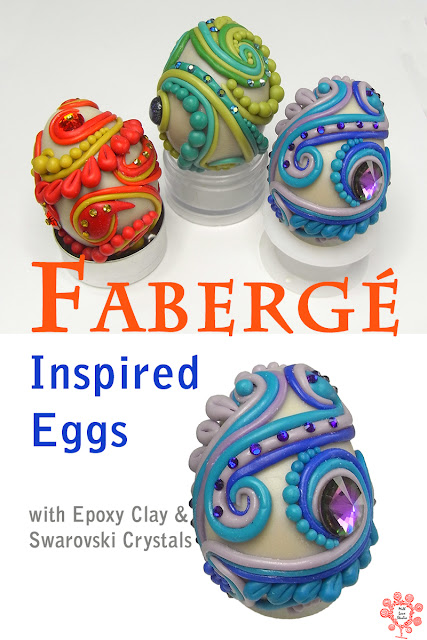Shopping List:
EnviroTex EasySculpt Epoxy Resin ClayColourants: Castin'Craft Resin Pigments and alcohol inks
2" polystyrene eggs
Embellie Gellie or Krystal Katana
2 x Swarovski flatback rivoli 2006 in colour of your choice
Swarovski flatback crystals SS8 in colours of your choice
G-S Hypo Cement
Talcum powder
Tissues and Methylated Spirits (denatured alcohol) or baby wipes
Teflon craft sheet
Gloves
Tools: clay blade, needle tool, timer,
How to Make Decorative Resin Clay Eggs
Tip: Before beginning to work with EasySculpt, put on a pair of close fitting gloves because resin clay is quite sticky when it's first mixed. It will be helpful to dust your gloves whenever the clay begins to stick to them.Cover the Egg
Measure out and mix together equal parts of EasySculpt Clay following the manufacturer’s instructions. Set a timer for 25 minutes and leave the mixed clay to firm up because initially, it will be too sticky and stretchy to cover the egg.Dust your gloves with powder and then flatten the clay into a circle. Place the center of the circle over the top of the egg.
The clay will still be quite soft and because it has some stretch in it, wrinkles will form in the bottom section of the egg. Use your gloved hand to smooth out the clay and set it aside. Set the timer for 10 minutes and then smooth again. Repeat again at 10 minute intervals until the egg is smooth. Roll the egg in your palms to give it a smooth all over finish.
Decorate the Egg
Apply a small amount of GS-Hypo Cement to the middle of the egg and attach a flat back Rivoli. Adhere another Rivoli on the opposite side of the egg in a slightly lower position.
Mix a small amount of EasySculpt. Roll it into three different sized balls.
Flatten one piece into a circle and add 2 drops of your choice of colour to the clay. Mix it in well. This will make the clay sticky and soft so powder your gloves as needed whilst you work the colour in. Clean your gloves with rubbing alcohol and a tissue to remove any residue.
Colour the other two balls with the other colourants you’ve chosen. Set the timer for 10 minutes to allow the clay to firm up a little before continuing.
Note: You will notice that some of the alcohol ink colours will fade as they cure.
Dust the Teflon sheet lightly with powder. Pull a small amount from one ball of clay and roll it on the sheet to form a snake 3mm (1/8”) thick and approximately 11.5cm (4 ½”) long.
Begin coiling the clay around the rivoli and then create an “S” curve down the side of the egg, finishing in an open circle.
Make additional coils in the other colours and place them alongside the first coil, following the same curve. Create another “S” curves around the other rivoli.
Form a piece of clay into a small log about ¼” wide. Cut it into pieces 6mm (¼”) long.
Cut some of these pieces in halves, some into quarters and some into smaller pieces.
Roll each one into a ball so that you have a variety of graduating sizes. Set these aside to firm up.
Roll out another ¼” wide log and cut it into 6mm (¼”) lengths. Roll each into a ball and then taper one end to form a teardrop shape.
Position these at an angle around the outside curves of the coils with the points facing in. Use adhesive to secure them if they have begun to cure. On some coils, attach graduating sized balls along the curve with the adhesive.
Position crystals along the middle coil in some of the “S” curves. If the clay is no longer sticky, use G-S Hypo Cement to attach them.
Now that you've finished your decorative Easter egg, make a few in different colour combinations. They look stunning displayed in ornate egg stands. Or place them in a bowl on your coffee table and admire them all year 'round.
Like this project? Pin it for later.
'Til next time.......

If you can't get enough of My Tutorials and you want even more inspiration, click here to find my books and printable pdfs



















No comments
Post a Comment